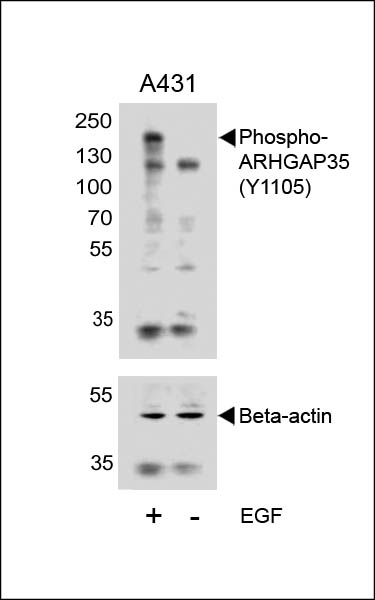Phospho-ARHGAP35(Y1105) antibody
Purified Rabbit Polyclonal Antibody (Pab)
- SPECIFICATION
- CITATIONS
- PROTOCOLS
- BACKGROUND

Application
| WB, E |
|---|---|
| Primary Accession | Q9NRY4 |
| Other Accession | P81128, Q91YM2 |
| Reactivity | Human |
| Predicted | Mouse, Rat |
| Host | Rabbit |
| Clonality | Polyclonal |
| Isotype | Rabbit IgG |
| Calculated MW | 170514 Da |
| Gene ID | 2909 |
|---|---|
| Other Names | Rho GTPase-activating protein 35, Glucocorticoid receptor DNA-binding factor 1, Glucocorticoid receptor repression factor 1, GRF-1, Rho GAP p190A, p190-A, ARHGAP35, GRF1, GRLF1, KIAA1722 |
| Target/Specificity | This antibody is generated from a rabbit immunized with a KLH conjugated synthetic peptide between 1090-1135 amino acids from human. |
| Dilution | WB~~1:500 E~~Use at an assay dependent concentration. |
| Format | Purified polyclonal antibody supplied in PBS with 0.09% (W/V) sodium azide. This antibody is purified through a protein A column, followed by peptide affinity purification. |
| Storage | Maintain refrigerated at 2-8°C for up to 2 weeks. For long term storage store at -20°C in small aliquots to prevent freeze-thaw cycles. |
| Precautions | Phospho-ARHGAP35(Y1105) antibody is for research use only and not for use in diagnostic or therapeutic procedures. |
| Name | ARHGAP35 (HGNC:4591) |
|---|---|
| Function | Rho GTPase-activating protein (GAP) (PubMed:19673492, PubMed:28894085). Binds several acidic phospholipids which inhibits the Rho GAP activity to promote the Rac GAP activity (PubMed:19673492). This binding is inhibited by phosphorylation by PRKCA (PubMed:19673492). Involved in cell differentiation as well as cell adhesion and migration, plays an important role in retinal tissue morphogenesis, neural tube fusion, midline fusion of the cerebral hemispheres and mammary gland branching morphogenesis (By similarity). Transduces signals from p21-ras to the nucleus, acting via the ras GTPase-activating protein (GAP) (By similarity). Transduces SRC- dependent signals from cell-surface adhesion molecules, such as laminin, to promote neurite outgrowth. Regulates axon outgrowth, guidance and fasciculation (By similarity). Modulates Rho GTPase- dependent F-actin polymerization, organization and assembly, is involved in polarized cell migration and in the positive regulation of ciliogenesis and cilia elongation (By similarity). During mammary gland development, is required in both the epithelial and stromal compartments for ductal outgrowth (By similarity). Represses transcription of the glucocorticoid receptor by binding to the cis- acting regulatory sequence 5'-GAGAAAAGAAACTGGAGAAACTC-3'; this function is however unclear and would need additional experimental evidences (PubMed:1894621). |
| Cellular Location | Cytoplasm, cytoskeleton, cilium basal body {ECO:0000250|UniProtKB:Q91YM2}. Cytoplasm {ECO:0000250|UniProtKB:Q91YM2}. Nucleus Cell membrane {ECO:0000250|UniProtKB:Q91YM2}. Note=In response to integrins and SDC4 and upon phosphorylation by PKC, relocalizes from the cytoplasm to regions of plasma membrane ruffling where it colocalizes with polymerized actin. {ECO:0000250|UniProtKB:Q91YM2} |
| Tissue Location | Detected in neutrophils (at protein level). |

Thousands of laboratories across the world have published research that depended on the performance of antibodies from Abcepta to advance their research. Check out links to articles that cite our products in major peer-reviewed journals, organized by research category.
info@abcepta.com, and receive a free "I Love Antibodies" mug.
Provided below are standard protocols that you may find useful for product applications.
Background
Represses transcription of the glucocorticoid receptor by binding to the cis-acting regulatory sequence 5'- GAGAAAAGAAACTGGAGAAACTC-3'. May participate in the regulation of retinal development and degeneration. May transduce signals from p21-ras to the nucleus, acting via the ras GTPase-activating protein (GAP). May also act as a tumor suppressor.
References
Nagase T.,et al.DNA Res. 7:347-355(2000).
Nakajima D.,et al.DNA Res. 9:99-106(2002).
Mural R.J.,et al.Submitted (JUL-2005) to the EMBL/GenBank/DDBJ databases.
Tikoo A.,et al.Gene 257:23-31(2000).
LeClerc S.,et al.J. Biol. Chem. 266:17333-17340(1991).
If you have used an Abcepta product and would like to share how it has performed, please click on the "Submit Review" button and provide the requested information. Our staff will examine and post your review and contact you if needed.
If you have any additional inquiries please email technical services at tech@abcepta.com.














 Foundational characteristics of cancer include proliferation, angiogenesis, migration, evasion of apoptosis, and cellular immortality. Find key markers for these cellular processes and antibodies to detect them.
Foundational characteristics of cancer include proliferation, angiogenesis, migration, evasion of apoptosis, and cellular immortality. Find key markers for these cellular processes and antibodies to detect them. The SUMOplot™ Analysis Program predicts and scores sumoylation sites in your protein. SUMOylation is a post-translational modification involved in various cellular processes, such as nuclear-cytosolic transport, transcriptional regulation, apoptosis, protein stability, response to stress, and progression through the cell cycle.
The SUMOplot™ Analysis Program predicts and scores sumoylation sites in your protein. SUMOylation is a post-translational modification involved in various cellular processes, such as nuclear-cytosolic transport, transcriptional regulation, apoptosis, protein stability, response to stress, and progression through the cell cycle. The Autophagy Receptor Motif Plotter predicts and scores autophagy receptor binding sites in your protein. Identifying proteins connected to this pathway is critical to understanding the role of autophagy in physiological as well as pathological processes such as development, differentiation, neurodegenerative diseases, stress, infection, and cancer.
The Autophagy Receptor Motif Plotter predicts and scores autophagy receptor binding sites in your protein. Identifying proteins connected to this pathway is critical to understanding the role of autophagy in physiological as well as pathological processes such as development, differentiation, neurodegenerative diseases, stress, infection, and cancer.


